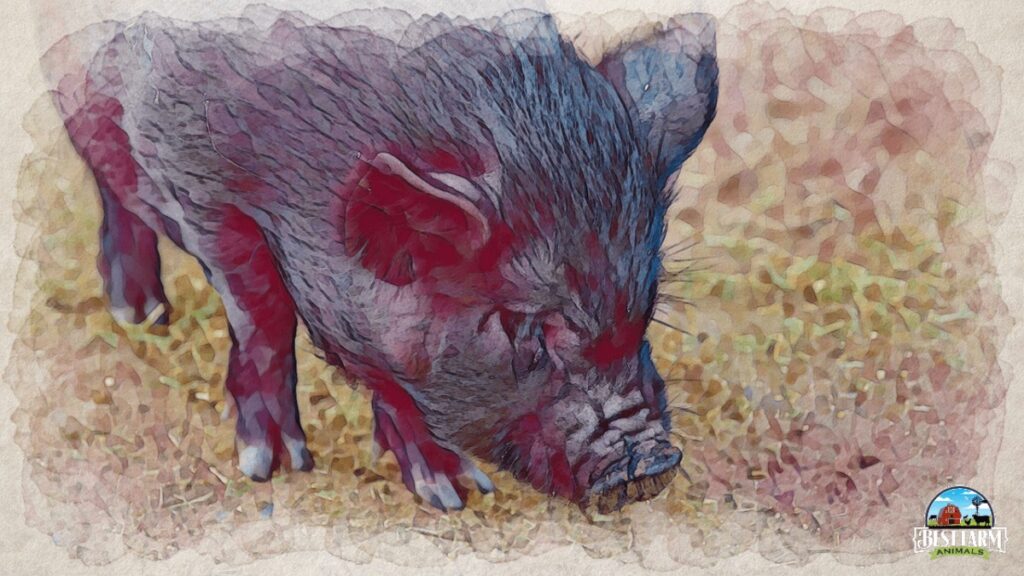Obvious Lethargy, A Main Sign of Swine Influenza
You should be able to spot a lethargic pig easily: they suddenly don’t move around as much as they usually do and lie down more often and for more extended periods. Your pig may also look quite pale, especially along their gum line, ears, and nose.
Lethargy is often a sign of illness such as swine influenza (a respiratory disease in pigs), and paying attention to your pig is vital. Signs of swine influenza (SIV) include coughing, sneezing, rapid, shallow breaths, a snotty nose, fever, and loss of appetite. Swine influenza is passable to humans so take care when treating a sick pig. It also passes very quickly among the herd.
Here are a few noticeable symptoms if your pig has swine influenza:
- Coughing
- Sneezing
- Taking shallow and strained breaths
- Discharge oozing from nose and eyes
- Loss of appetite
- Fever
Sickness May Cause a Pig Not to Eat
When a pig is ill, it may lose its appetite or be unable to digest food properly, which can cause it to lose interest in food. A sick pig not eating can indicate an infection, inflammation, or organ damage. Stress and digestive issues can also cause a pig to feel ill and refuse to eat.
A sick pig not eating can be terrifying because most pigs will continue to eat even when feeling unwell. So, take any abnormal eating behavior seriously and take your pig to the vet for an examination and diagnosis.
X-rays, fecal exams, blood work, and physical exams can help the vet diagnose a pig’s illness and lack of appetite. Depending on the results, the vet will devise a plan to get the pig healthy again, including medication, surgery, or dietary changes. With the proper treatment, the pig can get better soon and return to its usual appetite.
Steps to Take if Your Pig is Lethargic:
If you suspect Swine Influenza, take precautions to keep yourself safe. Wash your hands, avoid contact with any cuts or scrapes you have. Personally, I’d even change my clothes after helping my pig.
Follow these easy steps to treat your infected pig. There is no specific treatment for influenza; sadly, the illness has to run its course. But, you can avoid spreading it and help your pig to recover better. Isolate your pig to reduce the likelihood of passing it to other pigs (although it may already be spreading).
If your pig has a fever, give it antibiotics to help them avoid getting additional secondary infections. Usually, penicillin or streptomycin can be prescribed by your vet Give your pig electrolytes to help balance their blood pressure and give them more energy. Avoid further stressing them out.
First, isolate all sick pigs. Next, give antibiotics to all pigs with a fever or coughing for at least three days. Lastly, provide your pig with electrolytes. You can also make a simple electrolyte solution at home by mixing: 34 fluid ounces of water, 0.7 ounces glucose, 0.1 ounces salt, 0.08 ounces baking soda, and 0.05 ounces potassium chloride.
- Isolate all sick pigs
- Give antibiotics to all pigs with a fever or coughing for at least three days.
- Provide your pig with electrolytes
You can make a simple electrolyte solution at home by mixing:
- 34 fluid ounces of water
- 0.7 ounces glucose
- 0.1 ounces salt
- 0.08 ounces baking soda
- 0.05 ounces potassium chloride
My Most Used Pig Supplies
This list contains affiliate products. Affiliate products do not cost more but helps to support BestFarmAnimals and our goal to provide farm animal owners with accurate and helpful information.
Purina Pig Chow will last well (or Mazuri is popular, but I haven’t tried it), and the stainless steel non-skid bowls that will help keep the mess down.
A pig blanket to keep her warm. This one also has bright colors and helps to provide rooting without the destruction.
Pig Harness for walking and handling your pig. There are a lot to choose from, but this one is pretty easy to use. If you want one that has a separate leash, this looks like a good one.
A large crate for keeping her safe in your house at night and when you leave the house. This is essential. You’ll also want a litterbox, and I like mine with a lid for nighttime. Pine shavings are best, and you may be able to find them in larger quantities locally.
When you have accidents, Odoban will help eliminate odors. When you are potty training, these floor pads work great for keeping your house clean while training her to go in certain places.
You’ll also want an outdoor house to keep her warm when she gets outside time, an essential part of her development.
Dewormer- Ivermectin is the primary dewormer I use, although I do rotate with a non-ivermect ingredient once so that the worms don’t get immune to it.

